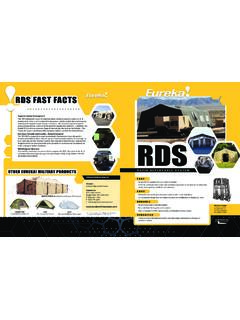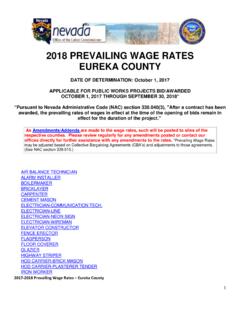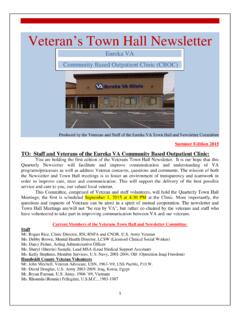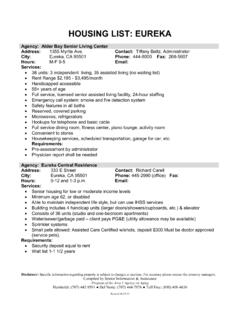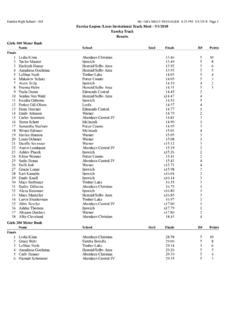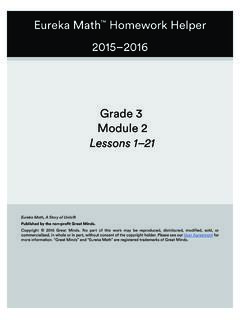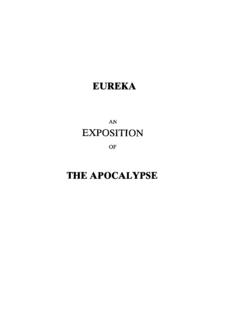Transcription of Standard Operating Procedure for - Missouri State University
1 Standard Operating Procedure for: eureka Amphibian and Manta Water Quality Multiprobe for Multiple Location Parameter Measurement (1200R02 eureka ) Missouri State University and Ozarks Environmental and Water Resources Institute (OEWRI) Prepared by: _____ Date: _____ OEWRI Quality Assurance Manager Approved by: _____ Date: _____ OEWRI Director ID: eureka Snapshot Revision: 2 April 2007 Page 2 of 10 Table of Contents Revision History .. 2 1 Identification of the test method .. 3 2 Applicable matrix or 3 3 Detection Limit .. 3 4 Scope of the test method .. 3 5 Summary of test method .. 3 6 Definitions .. 4 7 Interferences .. 4 8 Health and safety .. 5 9 Personnel qualifications .. 5 10 Equipment and supplies .. 5 11 Reagents and standards .. 5 12 Sample collection, preservation, shipment and storage .. 6 13 Quality control .. 6 14 Calibration and standardization .. 6 15 Procedure .. 7 16 Data acquisition, calculations, and reporting.
2 8 17 Computer hardware and software .. 8 18 Method performance .. 8 19 Pollution prevention .. 8 20 Data assessment and acceptable criteria for quality control 9 21 Corrective actions for out-of-control or unacceptable data .. 9 22 Waste management .. 9 23 References .. 9 24 Tables, diagrams, flowcharts and validation data .. 9 Revision History Revision number Revision date Revisions made (Indicate the section changed and what changes were made) 1 9/14/06 First version of this SOP. 2 4/30/07 Snapshot log designation vs timed log ID: eureka Snapshot Revision: 2 April 2007 Page 3 of 10 1 Identification of the test method Operation of the eureka Amphibian with Manta water quality multiprobe 2 Applicable matrix or matrices This instrument can be used for natural water samples. 3 Detection Limit The Operating ranges for this instrument are: temperature -5 to 50 C, conductivity 0 to 112 mS/m, Dissolved Oxygen (DO) 0 to 50 mg/L, pH 2 to 12, and turbidity 0 to 3000 NTU.
3 The range for depth measurements is 0 to 100m, however, the instrument currently has only a 3 m cable. 4 Scope of the test method This Procedure will be used as a field reference guide for the collection of water quality parameters. Water temperature, conductivity, pH, dissolved oxygen, and turbidity can be recorded using the eureka Amphibian and Manta water quality multiprobe. The eureka meter can also measure depth. The procedures described here list the set up, calibration and reporting procedures . The user should review the instrument manuals for further information about the units. 5 Summary of test method The eureka Water Quality Multiprobe uses a thermistor to measure temperature. Temperature influences the conductivity of water. As the temperature increases, conductivity increases, due to the increased movement of ions in the solution. Temperature changes in water can have extreme biological effects. In general, as the temperature of water increases, the amount of oxygen dissolved in the water decreases and there is a tendency for the amount of pollutants to increase.
4 The unit of measurement for temperature is C (Celsius). Conductivity is a measure of the ability of an aqueous solution to carry an electric current. The conductivity of water depends upon the presence of ions (their total concentration, mobility, valence, and relative concentrations) and on the temperature of the solution. Adding electrolytes such as salts, acids, or bases to pure water increases conductance. The conductivity of water is determined by measuring the resistance of ion flow in between charged plates because conductivity is inversely proportional to resistance. The eureka reports conductivity as mS/cm (milli Siemen / centimeter). Multiply this value by 1000 to report the conductivity value as S/cm. The eureka uses the membrane-electrode method for Dissolved Oxygen (DO). A reduction reaction in the cathode is caused by oxygen diffusing through the membrane of the sensor to create a current. This current is proportional to the concentration of oxygen dissolved in water.
5 DO is reported as mgDO/L. ID: eureka Snapshot Revision: 2 April 2007 Page 4 of 10 Potential of hydrogen (pH) is a unit used to show the degree of acidity on a scale of 0 to 14. The pH is a measure of the hydrogen ion (H+) activity in a solution. Activity of the hydrogen ion (as moles/L) can be calculated as: pH = -log10[H+]. Or, [H+] = 1/10pH. The pH scale is logarithmic, so that a decrease of 1 pH unit is equivalent to a ten fold increase in the hydrogen ion activity. For example, a solution that has a pH of is ten times more acidic than a solution with a pH of The neutral point for pH is temperature dependent; at 25 C pH is neutral, at 0 C the neutral point is pH and pH is the neutral point at 60 C ( Standard Methods, 2005). The glass-electrode method is used by the eureka . The known pH of a reference solution is determined by using two electrodes, a glass electrode and a reference electrode, and measuring the voltage (difference in potential) generated between the two electrodes.
6 The difference in pH between solutions inside and outside the thin glass membrane creates electromotive force in proportion to this difference in pH. There is no reporting unit for pH. Turbidity in water is caused by suspended and colloidal matter such as clay, silt, finely divided organic and inorganic matter, and plankton and other microscopic organisms. Turbidity is measured in the eureka using the light-transmission scattering method. The unit for turbidity is NTU (Nephelometric Turbidity Unit). The eureka turbidity probe has a wiper function that allows for the surface of the probe to be cleaned. The wiper is a replaceable foam pad. 6 Definitions Measurement Duplicate (MD): Two samples taken at the same time and place under identical circumstances and that are treated identically throughout field and laboratory procedures . Analysis of field duplicates indicates the precision associated with sample collection, preservation, and storage as well as laboratory procedures .
7 Laboratory Reagent Blank (LRB): An aliquot of deionized water treated as a sample in all aspects, except that it is not taken to the sampling site. The purpose is to determine if the if analytes or interferences are present in the laboratory environment, the reagents, or the apparatus. Relative Percent Difference (RPD): calculated as the difference between a sample and duplicate results, divided by the average of the sample and duplicate results, multiplied by 100%. 7 Interferences An improperly calibrated instrument can lead to erroneous results. See the manufacturer s instruction manual for proper calibration procedures and in sections 14 and 15. The eureka probes should be clean prior to use to avoid contamination for any of the analytes. ID: eureka Snapshot Revision: 2 April 2007 Page 5 of 10 8 Health and safety When wading in streams where water depths may be 1 meter deep or more, wear a life preserver and/or remove hip boots or chest waders.
8 Currents can force wading field workers into deep water and water-filled boots can make swimming difficult. When walking through densely vegetated areas along streams, be sure to look for and avoid toxic plants like poison ivy. Be sure to wear appropriate insect repellent and protective clothing for protection from mosquitoes, chiggers, and ticks. In addition, probe areas in your path with a walking stick to warn and disperse poisonous snakes like the cottonmouth and copperhead, which may inhabit riparian areas. Be sure to clean up with bacteria disinfectant soap and water after wading in streams. This is particularly important for streams that drain livestock areas, sewage treatment plant effluents, and other obvious pollution sources. Under no circumstances should you drink the water from any stream. 9 Personnel qualifications Water parameters will be collected by Missouri State University (MSU) graduate assistants who have received appropriate training, prior coursework, and field experience regarding the collection of water parameter data, and who are familiar with all of MSU s sample handling and labeling procedures .
9 10 Equipment and supplies eureka Water Quality Multiprobe, eureka Environmental Engineering, 2113 Wells Branch Parkway Suite 4400, Austin, Texas 78728, Telephone: 512-302-4333, Fax: 512-251-6842, a. Amphibian: includes a PDA and a water proof case b. Manta Multiprobe: includes calibration cup and probe guard c. Connection cables d. Spare parts kit Water Quality Field Book, Pen 11 Reagents and standards Deionized Water (DI) pH Reference Solution: pH Reference Solution: 147 S/cm Conductivity Standard : 1412 S/cm Conductivity Standard : 0 NTU Turbidity Standard : ID: eureka Snapshot Revision: 2 April 2007 Page 6 of 10 77 NTU Turbidity Standard : 12 Sample collection, preservation, shipment and storage Water samples are not collected using this Procedure . The analyses are conducted in situ and only data are collected and stored in the instrument. 13 Quality control Laboratory Reagent Blank (LRB): before leaving the laboratory, the analyst should perform one measurement of deionized water.
10 This operation will show that the auto-calibration has been performed and that the unit is reading blanks correctly. Measurement Duplicates (MD): Two measurement readings taken at the same sampling location. The results are compared after downloading the data. One MD will be collected with every ten samples collected in the field. 14 Calibration and standardization The eureka water quality probe will be calibrated every month before going into the field. The sensors in the probe will be cleaned every time the probe is returned to the laboratory. Soft brushes will always be used to clean the sensors. At no time will abrasives or cleansers be used. Clean and perform routine maintenance as outlined in the Manta operator s manual. Calibration procedures Temperature a. This sensor is factory calibrated and does not require calibration. b. The sensor should be checked annually against a NIST traceable thermometer. Record the deviation from the NIST thermometer in the instrument maintenance log book.

